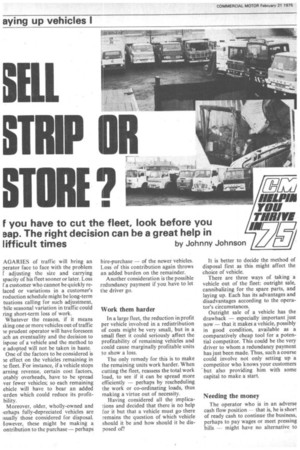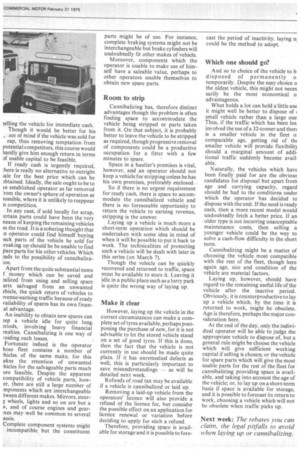SELL STRIP I II STORE?
Page 44

Page 45

If you've noticed an error in this article please click here to report it so we can fix it.
F you have to cut the fleet, look before you aap. The right decision can be a great help in
lifficult times by Johnny Johnson AGARIES of traffic will bring an perator face to face with the problem I adjusting the size and carrying tpacity of his fleet sooner or later. Loss Ca customer who cannot be quickly relaced or variations in a customer's roduction schedule might be long-term tuations calling for such adjustment, bile seasonal variation in traffic could ring short-term loss of work.
Whatever the reason, if it means tking one or more vehicles out of traffic le prudent operator will have foreseen ich an eventuality and the decision to ispose of a vehicle and the method to e adopted will not be taken in haste. One of the factors to be considered is le effect on the vehicles remaining in le fleet. For instance, if a vehicle stops arning revenue, certain cost factors, otably overheads, have to be spread ver fewer vehicles; so each remaining ehicle will have to bear an added urden which could reduce its profitbility.
Moreover, older, wholly-owned and ,erhaps fully-depreciated vehicles are isually those considered for disposal. Iowever, these might be making a ontribution to the purchase — perhaps hire-purchase — of the newer vehicles. Loss of this contribution again throws an added burden on the remainder.
Another consideration is the possible redundancy payment if you have to let the driver go.
Work them harder
In a large fleet, the reduction in profit per vehicle involved in a redistribution of costs might be very small, but in a small fleet it could seriously affect the profitability of remaining vehicles and could cause marginally profitable units to show a loss.
The only remedy for this is to make the remaining units work harder. When cutting the fleet, reassess the total work load, to see if it can be spread more efficiently — perhaps by rescheduling the work or co-ordinating loads, thus making a virtue out of necessity.
Having considered all the implicai:ions and decided that there is no help for it but that a vehicle must go there remains the question of which vehicle should it be and how should it be disposed of? It is better to decide the method of disposal first as this might affect the choice of vehicle.
There are three ways of taking a vehicle out of the fleet: outright sale, cannibalizing for the spare parts, and laying up. Each has its advantages and disadvantages according to the operator's circumstances.
Outright sale of a vehicle has the drawback — especially important just now — that it makes a vehicle, possibly in good condition, available as a comparatively cheap tool for a potential competitor. This could be the very driver to whom a redundancy payment has just been made. Thus, such a course could involve not only setting up a competitor who knows your customers ' but also providing him with some capital to make a start.
Needing the money
The operator who is in an adverse cash flow position — that is, he is short of ready cash to continue the business, perhaps to pay wages or meet pressing bills — might have no alternative to selling the vehicle for immediate cash.
Though it would be better for his ; ace of mind if the vehicle was sold for Tap, thus removing temptation from potential competitors, this course would hardly give him enough return in terms Df usable capital to be feasible.
If ready cash is urgently required, here is really no alternative to outright ;ale for the best price which can be Thtained. Ideally, the sale ought to be to ni established operator as far removed srom the owner's sphere of operation as )ossible, where it is unlikely to reappear n competition.
In any case, if sold locally for scrap, :ertain parts could have been the very neans of keeping the remaining vehicles 41 the road. It is a sobering thought that .n operator could find himself buying lack parts of the vehicle he sold for ,reaking up should he be unable to find pare parts for his other vehicles. Which ;ads to the possibility of cannibalizaion.
Apart from the quite substantial sums f money which can be saved and mlized from using and selling spare arts salvaged from an unwanted chicle, the quick return of vehicles to ;venue-earning traffic because of ready vailability of spares has its own finanal advantage.
An inability to obtain new spares can ;ep a vehicle idle for quite long, ;nods, involving heavy financial ;nalties. Cannibalizing is one way of voiding such losses.
Fortunate indeed is the operator hose fleet contains a number of :hides of the same make, for this akes the retention of unwanted hides for the salvageable parts much ore feasible. Despite the apparent compatibility of vehicle parts, hower, there are still a large number of mponents which are interchangeable tween different makes. Mirrors, steerr; wheels, lights and so on are but a ,v, and of course engines and gearxes may well be common to several assis.
Complete component systems might incompatible but the constituent parts might be of use. For instance, complete braking systems might not be interchangeable but brake cylinders will undoubtedly fit other makes of vehicle.
Moreover, components which the operator is unable to make use of himself have a saleable value, perhaps to other operators unable themselves to obtain new spare parts.
Room to strip
Cannibalizing has, therefore distinct advantages though the problem is often finding space to accommodate the vehicle being stripped or parts taken from it. On that subject, it is probably better to leave the vehicle to be stripped as required, though progressive removal of components could be a productive occupation for a fitter with a few minutes to spare. '
Space in a haulier's premises is vital, however, and an operator should not keep a vehicle for stripping unless he has his own premises, preferably enclosed.
So if there is no urgent requirement for ready cash, there is space to accommodate the cannibalized vehicle and there is no foreseeable opportunity to return the vehicle to earning revenue, stripping is the answer.
Laying up a vehicle is much more a short-term operation which should be undertaken with some idea in mind of when it will be possible to put it back to work. The technicalities of protecting such a vehicle will be dealt with later in this series (on March 7).
Though the vehicle can be quickly recovered and returned to traffic, space must be available to store it. Leaving it idle in a public place such as a lorry park is quite the wrong way of laying up.
Make it clear
However, laying up the vehicle in the correct circumstances can make a complete set of tyres available, perhaps postponing the purchase of new, for it is not advisable to let the stored vehicle stand on a set of good tyres. If this is done, then the fact that the vehicle is not currently in use should be made quite plain. If it has unremedied defects as well, this is particularly important to save misunderstandings — as will be detailed next week.
Refunds of road tax may be available if a vehicle is cannibalized or laid up.
Removing a laid-up vehicle from the operators' licence will also provide a refund of the licence fee, but consider the possible effect on an application for licence renewal or variation before deciding to apply for siich a refund.
Therefore, providing space is available for storage and it is possible to fore cast the period of inactivity. laying III could be the method to adopt.
Which one should go?
And so to choice of the vehicle to b, disposed of permanently o temporarily. Despite the easy choice o the oldest vehicle, this might not neces sarily be the most economical o advantageous.
What holds a lot can hold a little am it might well be better to dispose of small vehicle rather than a large one Thus, if the traffic which has been los involved the use of a 32-tonner and then is a smaller vehicle in the fleet o: comparable age, getting rid of thc smaller vehicle will provide flexibilit3 should a marginal amount of additional traffic suddenly become available.
Naturally, the vehicles which havc been finally paid for are the obvious candidates for disposal but apart from age and carrying capacity, regard should be had to the conditions under which the operator has decided to dispose with the unit. If the need is ready cash, then a more recent model would undoubtedly fetch a better price. If an older type is not incurring unacceptable maintenance costs, then selling a younger vehicle could be the way to solve a cash-flow difficulty in the short term.
Cannibalizing might be a matter of choosing the vehicle most compatible with the rest of the fleet, though here again age, size and condition of the vehicle are material factors.
Laying up, however, should have regard to the remaining useful life of the vehicle after the inactive period. Obviously, it is counterproductive to lay up a vehicle which, by the time it is returned to work, might be obsolete. Age is therefore, perhaps the major consideration here.
At the end of the day, only the individual operator will be able to judge the appropriate vehicle to dispose of, but a general rule might be choose the vehicle which will give sufficient working capital if selling is chosen; or the vehicle for spare parts which will give the most usable parts for the rest of the fleet for cannibalizing providing space is available, and taking into account the age of the vehicle; or, to lay up on a short-term basis if space is available for storage, and it is possible to forecast its return to work, choosing a vehicle which will not be obsolete when traffic picks up.
Next week: The rebates you can claim, the legal pitfalls to avoid when laying up or cannibalizing.












































































































